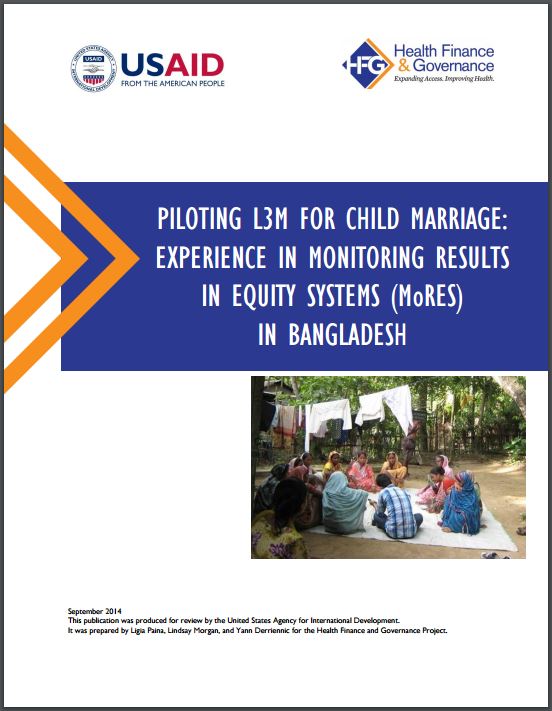Piloting L3M for Child Marriage: Experience in Monitoring Results in Equity Systems (MoRES) in Bangladesh
Categories: Health Systems Research, Maternal, Neonatal and Child Health (MNCH), Publications
 Resource Type: Report
Resource Type: Report
Authors: Ligia Paina, Lindsay Morgan, Yann Derriennic
Published: 09/2014
Resource Description:
Child marriage is a symptom of poverty and gender inequalities. Girls who marry early are more likely to die from maternal health-related causes; are less likely to stay in school; and are more likely to participate in a vicious cycle to reinforce intergenerational poverty. In Bangladesh, early marriage remains a significant challenge. Despite the adoption of an Act on Minimum Age of Marriage, which specifies a minimum legal marriage age of 18 for girls and 21 for boys, around three-fourths of girls are married before they reach their 18th birthday; and more than 55 percent become mothers before they are 19. Though early marriage is declining in Bangladesh, these reductions are most noticeable among the wealthy, while the decline in early marriage happens at a slower pace among the poor.
In 2012, USAID-Bangladesh approached UNICEF to explore possible areas of cooperation around delaying child marriage. UNICEF partnered with Health Finance and Governance (HFG), and other key stakeholders including the Ministry of Women and Children Affairs (MoWCA), the Ministry of Social Welfare (MSW)’s Department of Social Services (DSS), local NGOs, and Child Protection Networks, to design and implement a monitoring framework for assessing implementation of tracer interventions to delay child marriage and measuring social norms.
This activity builds on the existing UNICEF-wide monitoring framework – Monitoring Results for Equity Systems (MoRES). Monitoring Results for Equity Systems (MoRES) is UNICEF’s global monitoring framework that was recently introduced in Bangladesh and other countries. MoRES proposes a hierarchy of information to facilitate the monitoring and evaluation of UNICEF programs. Level 3—which is the subject of this report—monitors the extent to which UNICEF programs contribute to reductions in the barriers and bottlenecks identified in Level 1. The level 3 monitoring approach (L3M) pilot for child marriage described in this report focuses on examining how two of UNICEF’s Child Protection activities – adolescent stipends and conditional cash transfers – contribute to reductions in three priority bottlenecks: social norms, financial access, and legislation/policy.
Download



